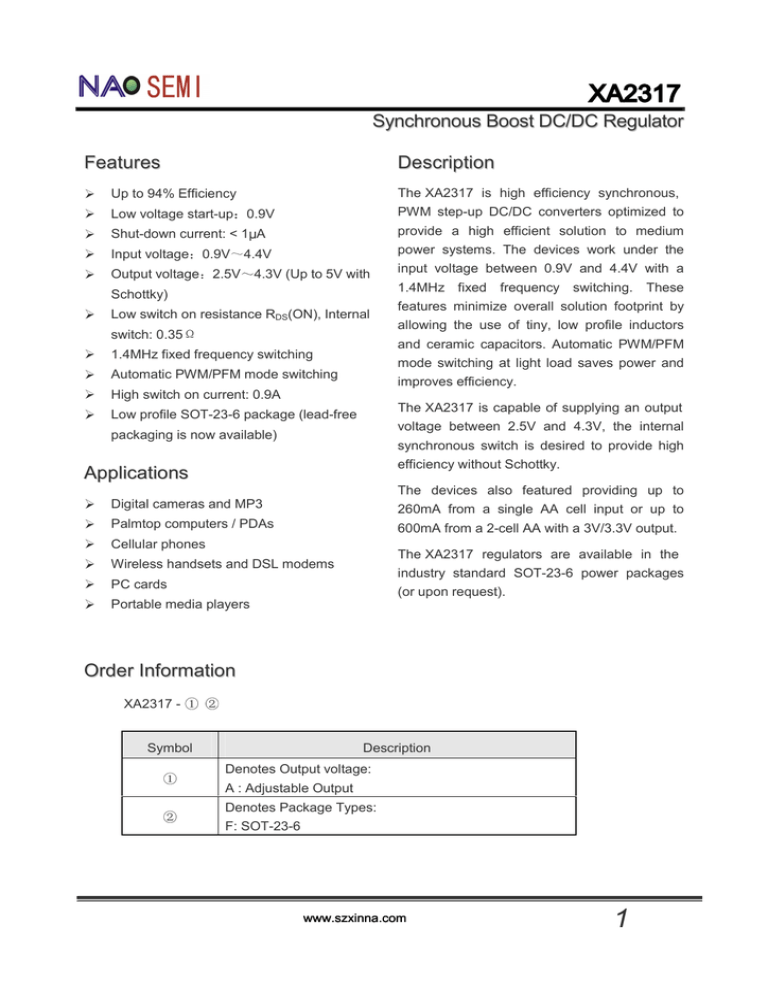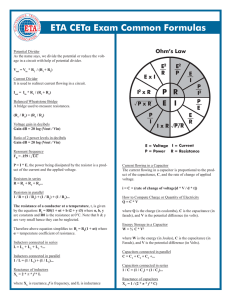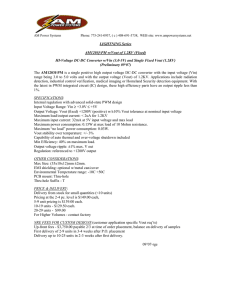XA2317 en
advertisement

XA2317 Synchronous Boost DC/DC Regulator Features Description Up to 94% Efficiency The XA2317 is high efficiency synchronous, Low voltage start-up 0.9V PWM step-up DC/DC converters optimized to Shut-down current: < 1µA provide a high efficient solution to medium Input voltage 0.9V 4.4V power systems. The devices work under the : : ~ Output voltage:2.5V~4.3V (Up to 5V with Schottky) Low switch on resistance RDS(ON), Internal switch: 0.35 Ω input voltage between 0.9V and 4.4V with a 1.4MHz fixed frequency switching. These features minimize overall solution footprint by allowing the use of tiny, low profile inductors and ceramic capacitors. Automatic PWM/PFM 1.4MHz fixed frequency switching mode switching at light load saves power and Automatic PWM/PFM mode switching improves efficiency. High switch on current: 0.9A The XA2317 is capable of supplying an output Low profile SOT-23-6 package (lead-free voltage between 2.5V and 4.3V, the internal packaging is now available) synchronous switch is desired to provide high Applications efficiency without Schottky. The devices also featured providing up to Digital cameras and MP3 260mA from a single AA cell input or up to Palmtop computers / PDAs 600mA from a 2-cell AA with a 3V/3.3V output. Cellular phones The XA2317 regulators are available in the Wireless handsets and DSL modems industry standard SOT-23-6 power packages PC cards (or upon request). Portable media players Order Information XA2317 - ①② Symbol Description ① Denotes Output voltage: ② Denotes Package Types: A : Adjustable Output F: SOT-23-6 www.szxinna.com 1 XA2317 Typical Applications L 2.2uH DC+ 1 0.9V to 4.4V SW 6 CIN 20uF VOUT 5 VOUT VIN R1 3 4 EN FB COUT 20uF R2 GND 2 Figure 1: Typical Application Circuit L 2.2uH D 1 SINGLE AA CELL + CIN 4.7uF SW 6 5 VIN M1 SI2306DS VOUT VOUT R3 4 OFF ON EN FB 3 510K COUT 4.7uF GND 2 R4 R1 1.02M R2 604K Q1 2N3904 510K Figure 2: Single Cell to 3.3V Synchronous Boost Converter with Load Disconnect in Shutdown. www.szxinna.com 2 XA2317 2 L 4.7uH Ω OPTIONAL SNUBBER 1nF D 1 LITHIUM CELL + CIN 4.7uF SW VOUT 5 6 VIN VOUT R1 4 OFF ON EN FB 1.02M 3 COUT 4.7uF GND 2 100pF R2 332K Figure 3: Single Lithium Cell to 5V with Load 250mA C1 1uF L 4.7uH 1 SW SINGLE AA CELL 6 CIN 10uF 5 VOUT VIN 4 EN FB 3 R1 1.02M R2 750K GND D1 D2 COUT1 10uF VOUT1 3V 90mA COUT2 10uF 2 Figure 4: Single Cell AA Cell to ±3V Synchronous Boost Converter www.szxinna.com 3 XA2317 Pin Assignment TOP VIEW VIN 6 1 SW VOUT 5 2 GND PIN Number EN 4 PIN Name Function 1 SW Switch Output 2 GND Ground 3 FB Feedback 4 EN 5 VOUT Output 6 VIN Input SOT23- 6L 3 FB ON/OFF Control (High Enable) SOT23-6L Absolute Maximum Ratings (Note 1) Power Dissipation……………………………………..…………………………...Internally limited ~ + 6.6V V ………………………………………………...……………………………....- 0.3 V ~ + 6.6V V …….…………………………………..…………………………………………- 0.3 V ~ + 6.6 V V , V ……………………………………...………………………………………- 0.3 V ~ + 6.6 V Operating Temperature Range (Note 2)…………………………………………- 30℃ ~ + 85℃ Lead Temperature (Soldering 10 sec.) ……………………………………………………+ 300℃ Storage Temperature Range …………………………………...………………..- 65℃ ~ + 125℃ VIN ……………………………………………………………………………………..- 0.3 V OUT SW EN OUT Note 1: Absolute Maximum Ratings are those values beyond which the life of a device may be impaired. Note 2: The XA2317 are guaranteed to meet performance speci fications from 0°C to 70°C. Specifications over the – 30°C to 85°C operating temperature range are assure d by design, characterization and correlation with statistical process controls. www.szxinna.com 4 XA2317 Electrical Characteristics Operating Conditions: TA=25 ℃, V PARAMETER IN=1.2V, VOUT=3.3V unless otherwise specified. CONDITIONS Output Voltage Range (Adj.) Minimum Start-Up MIN TYP MAX UNITS 5 V 2.5 Voltage (Note 3) Minimum Operating Voltage ILOAD = 1mA 0.9 1.1 V EN = VIN 0.6 0.75 V 1.1 1.4 1.7 MHz 80 87 % 40 ns Switching Frequency Max Duty Cycle VFB = 1.15V Current Limit Delay to Output (Note 4) Feedback Voltage 1.165 1.212 1.241 Feedback Input Current VFB = 1.22V (Note 4) NMOS Switch Leakage VSW = 5V 0.1 5 µA PMOS Switch Leakage VSW = 0V 0.1 5 µA NMOS Switch On Resistance VOUT = 3.3V 0.35 Ω PMOS Switch On Resistance VOUT = 3.3V 0.45 Ω 950 mA 260 µA NMOS Current Limit 1 V 700 Measured Quiescent Current (Active) On VOUT, No nA switching Shutdown Current VEN=0V, Including Switch 0.1 1 Leakage En Input High 1 V En Input Low En Input Current VEN = 5.5V µA 0.35 V 1 µA 0.01 Note 3: Minimum VIN operation after start-up is only limited by the battery’s ability to provide the necessary power as it enters a deeply discharged state. Note 4: Specification is guaranteed by design and not 100% tested in production. www.szxinna.com 5 XA2317 Typical Performance Characteristics Efficiency vs. Output Current (Vout=3.3V) 100 90 90 80 80 VIN=1.5V VIN=1V 70 Efficiency (%) Efficiency (%) 100 60 VIN=1.2V 50 40 30 V IN =2V VIN =2.7V 50 40 30 10 10 0 0 100 VIN=2.5V 60 20 100 1000 10 100 1000 Output Current (mA) Output Current (mA) Efficiency vs. Output Current (Vout=4.2V) Efficiency vs. Output Current (Vout=5V) 100 90 90 80 80 VIN =3V 70 60 Efficiency (%) Efficiency (%) 70 20 10 Efficiency vs. Output Current (Vout=3.3V) VIN =2V 50 40 30 70 50 40 30 20 10 10 0 0 100 1000 Output Current (mA) VIN =2V 60 20 10 V IN =3.6V 10 100 Output Current (mA) www.szxinna.com 6 1000 XA2317 Pin Functions SW (Pin1): Switch Pin. Connect inductor between SW and VIN. Keep these PCB trace lengths as short and wide as possible to reduce EMI and voltage overshoot. GND (Pin 2): Signal and Power Ground. Provide a short direct PCB path between GND and the (–) side of the output capacitor(s). FB (Pin 3): Feedback Input to the gm Error Amplifier. Connect resistor divider tap to this pin. The output voltage can be adjusted from 2.5V to 5V by: VOUT = 1.212V • [1 + (R1/R2)] EN (Pin 4): Logic Controlled Shutdown Input. EN = High: Normal free running operation, 1.4MHz typical operating frequency. EN = Low: Shutdown, quiescent current <1µA. Output capacitor can be completely discharged through the load or feedback resistors. VOUT (Pin 5): Output Voltage Sense Input and Drain of the Internal Synchronous Rectifier MOSFET. Bias is derived from VOUT. PCB trace length from VOUT to the output filter capacitor(s) should be as short and wide as possible. VIN (Pin 6): Battery Input Voltage. The device gets its start-up bias from VIN. Once VOUT exceeds VIN, bias comes from VOUT. Thus, once started, operation is completely independent from VIN. Operation is only limited by the output power level and the battery’s internal series resistance. Operation The XA2317 are 1.4MHz, synchronous boost converters housed in a 6-lead ThinSOT package. Able to operate from an input voltage below 1V, the devices feature fixed frequency, current mode PWM control for exceptional line and load regulation. With its low RDS(ON) and gate charge internal MOSFET switches, the devices maintain high efficiency over a wide range of load current. Detailed descriptions of the three distinct operating modes follow. Operation can be best understood by referring to the Block Diagram. Low Voltage Start-Up The XA2317 will start up at a typical VIN voltage of 0.9V or higher. The low voltage start-up circuitry controls the internal NMOS switch up to a maximum peak inductor current of 850mA (typ), with an approximate 1.5ms off-time during start-up, allowing the devices to start up into an output load. Once VOUT exceeds 2.3V, the start-up circuitry is disabled and normal fixed frequency PWM operation is initiated. In this mode, the XA2317 operate independent of VIN, allowing extended operating time as the battery can droop to several tenths of a volt without affecting output voltage regulation. The limiting factor for the application becomes the ability of the battery to supply sufficient energy to the output. Low Noise Fixed Frequency Operation Oscillator: The frequency of operation is internally set to 1.4MHz. Error Amp: The error amplifier is an internally compensated transconductance type (current output) with a transconductance (gm) = 33 microsiemens. The internal 1.212V reference voltage is compared to the voltage at the FB pin to www.szxinna.com 7 XA2317 generate an error signal at the output of the error amplifier. A voltage divider from VOUT to ground programs the output voltage via FB from 2.5V to 5V using the equation: VOUT = 1.212V • [1 + (R1/R2)] Current Sensing: A signal representing NMOS switch current is summed with the slope compensator. The summed signal is compared to the error amplifier output to provide a peak current control command for the PWM. Peak switch current is limited to approximately 850mA independent of input or output voltage. The current signal is blanked for 40ns to enhance noise rejection. Zero Current Comparator: The zero current comparator monitors the inductor current to the output and shuts off the synchronous rectifier once this current reduces to approximately 20mA. This prevents the inductor current from reversing in polarity improving efficiency at light loads. Antiringing Control: The antiringing control circuitry prevents high frequency ringing of the SW pin as the inductor current goes to zero by damping the resonant circuit formed by L and CSW (capacitance on SW pin). Burst Mode Operation Portable devices frequently spend extended time in low power or standby mode, only switching to high power drain when specific functions are enabled. In order to improve battery life in these types of products, high power converter efficiency needs to be maintained over a wide output power range. In addition to its high efficiency at moderate and heavy operation that improves efficiency of the power converter at light loads. Burst mode operation is initiated if the output load current falls below an internally programmed threshold. Once initiated, the Burst Mode operation circuitry shuts down most of the device, only keeping alive the circuitry required to monitor the output voltage. When the output voltage has drooped approximately 1% from nominal, the XA2317 wakes up and commences normal PWM operation. The output capacitor recharges and causes the XA2317 to reenter sleep if the output load remains less than the sleep threshold. The frequency of this intermittent PWM or burst operation is proportional to load current; that is, as the load current drops further below the burst threshold, the XA2317 turns on less frequently. When th e load current increases above the burst threshold, the XA2317 will resume continuous PWM operat ion seamlessly. Referring to the Block Diagram, an optional capacitor (CFF) between VOUT and FB in some circumstances can reduce the peak-to-peak VOUT ripple and input quiescent current during Burst Mode operation. Typical values for CFF range from 15pF to 220pF. PCB Layout Guidelines The high speed operation of the XA2317 demands carefu l attention to board layout. You will not get advertised performance with careless layout. Figure 5 shows the recommended component placement. A large ground pin copper area will help to lower the chip temperature. A multilayer board with a separate ground plane is ideal, but not absolutely necessary. www.szxinna.com 8 XA2317 Figure 5: Recommended Component Placement for Single Layer Board : Note 5 Recommended component placement: traces carrying high current are direct. Trace area at FB pin is small .Lead length to battery is short. Applications Information Inductor Selection The XA2317 can utilize small surface mount and chip ind uctors due to their fast 1.4MHz switching frequency. A minimum inductance value of 3.3uH is necessary for 3.6V and lower voltage applications and 4.7uH for output voltages greater than 3.6V. Larger values by reducing the inductor ripple current. Increasing the inductance above 10uH will increase size while providing little improvement in output current capability. The inductor current ripple is typically set for 20% to 40% of the maximum inductor current (IP). High frequency ferrite core inductor materials reduce frequency dependent power losses compared to cheaper powdered iron types, improving efficiency. The inductor should have low ESR (series resistance of the windings) to reduce the I2R power losses, and must be able to handle the peak inductor current without saturating. Molded chokes and some chip inductors usually do not have enough core to support the peak inductor currents of 850mA seen on the XA2317. To minimize radiated noise, use a toroid, pot core or shielded bobbin inductor. See Table 1 for some suggested components and suppliers. In continuous mode, the source current of the top MOSFET is a square wave of duty cycle VOUT/VIN. To prevent large voltage transients, a low ESR input capacitor sized for the maximum RMS current must be used. The maximum RMS capacitor current is given by: www.szxinna.com 9 XA2317 This formula has a maximum at VIN = 2VOUT, where IRMS = IOUT/2. This simple worst-case condition is commonly used for design because even significant deviations do not offer much relief. Note that the capacitor manufacturer’s ripple current ratings are often based on 2000 hours of life. This makes it advisable to further derate the capacitor, or choose a capacitor rated at a higher temperature than required. Always consult the manufacturer if there is any question. The selection of COUT is driven by the required effective series resistance (ESR). Typically, once the ESR requirement for COUT has been met, the RMS current rating generally far exceeds the IRIPPLE(P-P) requirement. The output ripple ∆VOUT is determined by: Where f = operating frequency, COUT = output capacitance and ∆IL = ripple current in the inductor. For a fixed output voltage, the output ripple is highest at maximum input voltage since ∆IL increases with input voltage. Aluminum electrolytic and dry tantalum capacitors are both available in surface mount configurations. In the case of tantalum, it is critical that the capacitors are surge tested for use in switching power supplies. An excellent choice is the AVX TPS series of surface mount tantalum. These are specially constructed and tested for low ESR so they give the lowest ESR for a given volume. Other capacitor types include Table 2 shows a list of several ceramic capacitor manufacturers. Consult the manufacturers directly for detailed information on their entire selection of ceramic parts. www.szxinna.com 10 XA2317 Table 1: Suggested Inductors Vendor Sumida (847)956-0666 www.sumida.com Coilcraft (847)639-6400 www.coilcraft.com Toko (408)432-8282 www.takoam.com Murata www.murata.com Part Inductance (uH) MAM DCR (mΩ) Height (mm) CDRH5D18-4R1 4.1 57 2.0 CDRH5D18-100 10 124 2.0 CDRH3D16-4R7 4.7 105 1.8 CDRH3D16-6R8 6.8 170 1.8 CR43-4R7 4.7 109 3.5 CR43-100 10 182 3.5 CMD4D06-4R7MC 4.7 216 0.8 CMD4D06-3R3MC 3.3 174 0.8 DS1608-472 4.7 60 2.9 DS1608-103 10 75 2.9 DS1608C-472 4.7 90 2.9 D52LC-4R7M 4.7 84 2.0 D52LC-100M 10 137 2.0 LQH3C4R7M24 4.7 195 2.2 Table 2: Suggested Capacitors for CIN and COUT Component Supplier Part No. Capacitance (uF) Case Size TDK C1608JB0J475M 4.7 0603 TDK C2012JB0J106M 10 0805 MURATA GRM188R60J475KE19 4.7 0603 MURATA GRM219R60J106ME19 10 0805 TAIYO YUDEN JMK107BJ475RA 4.7 0603 TAIYO YUDEN JMK107BJ106MA 10 0603 TAIYO YUDEN JMK212BJ106RD 10 0805 www.szxinna.com 11 XA2317 Packaging Information Symbol Dimensions In Millimeters Min Max Dimensions In Inches Min Max A 1.050 1.250 0.041 0.049 A1 0.000 0.100 0.000 0.004 A2 1.050 1.150 0.041 0.045 b 0.300 0.500 0.012 0.020 c 0.100 0.200 0.004 0.008 D 2.820 3.020 0.111 0.119 E 1.500 1.700 0.059 0.067 E1 2.650 2.950 0.104 0.116 e 0.950(BSC) 0.037(BSC) e1 1.800 2.000 0.071 0.079 L 0.300 0.600 0.012 0.024 θ 0° 8° 0° 8° . www.szxinna.com 12




